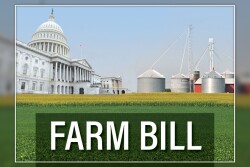Senate Ag Committee
With Congress passing another extension, some economists suggest a new reality may be setting in: the era of comprehensive Farm Bills could be ending, replaced by a piecemeal approach in Washington.
The Senate and House each have their own Committee proposals for President Trump’s Big Beautiful Bill. There are some key differences in each that could impact farmers and ranchers.
The CR includes nearly $110 billion in disaster and farmer aid, which includes $10 billion in farmer aid and $21 billion ag disaster aid. $2 billion of that disaster aid is specifically for livestock producers. The measure also includes a one-year extension of the 2018 Farm Bill.
The Rural Prosperity and Food Security Act, which builds on the proposal Stabenow released in May, includes $39 billion in new resources “to keep farmers farming, families fed and rural communities strong.”
Sen. John Thune (R-S.D.) wins Majority Leader race. Sen. Rick Scott (R-Fla.) was eliminated on the first ballot. And Thune beat Sen. John Cornyn (R-Tex.) 29-24 on the second ballot.
John Newton, former Senate Ag Committee economist and now executive head at Terrain, highlights three priorities and a timeframe for a final farm bill.
From differences within Title I of the new farm bill to possible ways both the Senate and House Ag Committee are working to find more funds, U.S. Ag Secretary Tom Vilsack spoke one-on-one with AgriTalk this week.
The farm bill finally saw some movement in Washington last month, but the Ag Economists’ Monthly Monitor found most economists don’t think it will be passed this year, with some even saying it could be as late as 2026.
The House Ag Committee on Thursday will mark up the House farm bill. House Ag Chair GT Thompson told AgriTalk the panel will have the votes to clear the panel, but he has yet to receive any firm Democratic support.
House Ag Committee Chairman G.T. Thompson, along with other members, is seeking additional funding sources for the bill, but that will likely be the biggest farm bill hurdle that may trip up lawmakers.
While Sen. McConnell says the budget has little give, Sen. Boozeman has consistently said he will not support a farm bill that doesn’t provide an increase in the Price Loss Coverage (PLC) program’s reference prices.
It’s not as simple as you might think. House Ag Chair G.T. Thompson shares a rundown of the funding and extension processes. He says the ag committees need to find new dollars to expand the farm bill budget.
Senate Ag Chair Debbie Stabenow, (D-Mich.) says there will be no new funding for the 2023 farm bill. However, Stabenow stressed she will not allow a cut in conservation funding.
The Senate and House Ag committees are facing delays in drafting the next farm bill, and it is expected to be the most expensive farm bill to date, clocking in at around $1.5 trillion.
Rep. Thompson signaled he wants to hear “commitment from everyone, including the president, that we will get this done and in the manner I’ve been speaking about. Bipartisan, bicameral, on time and highly effective.’”
Lenders In the hearing seemed to agree on a boost to lending limits in USDA guaranteed loans as lawmakers ready for the next farm bill.
“The prioritization of resource concerns must be left to the local level where producers decide how they can best address their unique and varied landscapes and needs,” said Sen. John Boozman.
SNAP, which historically receives the greatest amount of farm bill funding, will see an 82% increase of a quarter-trillion-dollars.
The House will take the reins in writing farm bill 2023. House Ag Chairman Thompson says the pen is “firmly” in his hand, with few tweaks to be made from 2018. The Senate says their version is nearly complete.
A Senate Ag Committee hearing Thursday on the new farm bill raised a issue that is now evident: the Title 1 farm bill safety net can no longer deal with the current ag environment.
“For the next two years, I am intensely focused on… leading the passage of the next five-year Farm Bill, which determines our nation’s food and agriculture policies,” says Sen. Stabenow.
Titled the “Seeding Rural Resilience Act,” the bill’s aim is to curb the rising rate of farmer suicides in America.
Some long-time Washington contacts still give the odds of a farm bill this year at only 15%.

















